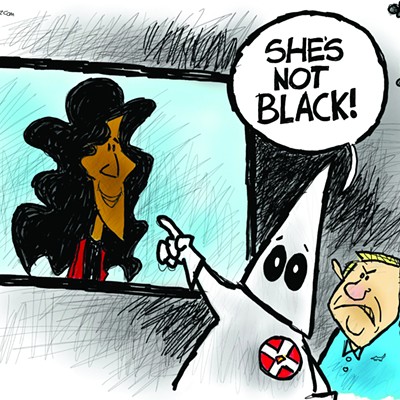Probably not, though plenty of court battles loom over the passage of Prop 200, the so-called "Protect Arizona Now" initiative. The judiciary will soon be wrestling with the question of how wide a net the proposition casts over welfare and other state programs, including health care services. At the same time, the feds will be reviewing the impact of requiring proof of citizenship on the Voting Rights Act, which could tangle up implementation of the second portion of the initiative. See you in court!
By the way, the Weekly spread before the election had Prop 200 as an 8-point favorite. It won by nearly 12 points.
What was the most surprising call made by voters?
The dumbshit rejection of Prop 102, which would have allowed universities to hold interest in companies launched by faculty members. This one had little organized opposition and proponents spent $468,000 trying to get it passed.
The TW spread had Prop 102 winning statewide by 10 percentage points; it lost by 4.
So is Pima County still a blue island in the red state of Arizona?
Sure looks that way. Kerry won Pima County by more than 5 percentage points, while losing Arizona by 9 percentage points. (The Weekly spread had Kerry as a 3-point favorite down here and Bush as a 4-point favorite statewide.) Pima County voters also favored the Democrats running for Corporation Commission (who lost), rejected Prop 200 by about 3 percentage points and supported Prop 102 by nearly 6 points.
We've heard all about values deciding the presidential election, blah, blah, blah. What was the underlying local lesson in Tuesday's election results?
Incumbency remains the most powerful force in Pima County politics. On the county level, it was obvious last summer, when nobody even filed to run against the Pima County Board of Supervisors or most of the other county line offices. (A trio of Libertarians later won ballot status as write-in candidates against three of the supes.)
Sheriff Clarence Dupnik beat his Republican challenger by nearly 15 percentage points, covering the 11-point Weekly spread. The only incumbent not going back to work is retiring Pima County Assessor Rick Lyons; Democrat Bill Staples beat Republican Bill Heuisler by 9 percentage points based mostly on the countywide Democratic voter edge. TW's spread had Staples favored by a touchdown.
On the state level, we saw a little more competition--perhaps because the state's Clean Elections program provides candidates with fat checks for campaigns. But again, incumbency was the defining factor. The incumbent Republicans on the Corporation Commission easily knocked aside Democratic challengers. And in legislative races, all the current lawmakers in these parts fended off challenges. Even Republican Rep. Jennifer Burns held onto her seat, despite the fact that Democrats outnumber Republicans in District 25.
Hey, county election results on the Web say less than 67 percent of the voters cast a ballot. What happened to our 80 percent turnout?
We direct your attention to the note atop that canvass that reminds us these results are unofficial and unaudited. County Recorder F. Ann Rodriguez tells us that election officials are still counting about 61,000 early ballots that came in before Election Day, as well as about 12,000 "provisional" ballots that may or may not be valid. Rodriguez--who, incidentally, was Pima County's top vote-getter, picking up more than 222,000 votes--estimates that about 80 percent of the provisional ballots will check out OK.
When you add an estimated 68,000 to the roughly 297,000 votes already counted in Pima County, you get a nice round 365,000 ballots--which comes out to an 81.4 percent turnout. (The number is even more impressive when you consider that back in May, after Rodriguez had cleared deadwood from the voter rolls, the number of voters stood at roughly 386,000.)
The Weekly set the over/under at 81 percent, so that proposition remains too close to call. We'll check back once the final number is certified. At any rate, it's a record number of Pima County residents voting. For comparison, 77 percent of the electorate, or 289,193 voters, cast a ballot in 2000; that was the highest turnout since 1992, when 287,718 people voted.
How on earth did Republican Joe Sweeney end up pulling more than 50,000 votes against Congressman Raúl Grijalva?
Because a lot of people have no idea who Sweeney is or what he stands for, while others really hate Grijalva, Democrats or Mexicans. (In some cases, all three.) Sweeney won La Paz and Yuma counties and pretty much tied Grijalva in Maricopa County. The perennial candidate is already laying the groundwork for his 2006 run.
District-wide, Grijalva won by about 26 percentage points, meaning he was unable to cover the Weekly's 38-point spread.
The most recent numbers available show turnout in Congressional District 7 was about 55 percent. Although that number is likely to tick upward by the time the final count is done, it's considerably fewer voters than the 68 percent who voted in Congressional District 8, where Republican Jim Kolbe beat Democrat Eva Bacal by about 24 percent.
A correction to last week's story: In our haste to beat our midnight deadline, we mistakenly declared Kolbe had covered a 26-point spread.
What's the impact of the different voter turn-out percentages in the congressional districts?
Here's an odd twist: According to the most recent numbers available from the Secretary of State's Office as of press time, Bacal outpolled Grijalva by about 2,700 votes.
What happened with the other Weekly spreads?
· We had Prop 300, which would have raised lawmakers' salaries, as a 12-point underdog; it lost by more than 20 percentage points.
· Pima County Supervisor Ann Day was a 75-point favorite over Libertarian Sandra Abbey; Day won by about 60 percentage points.
· State Sen. Gabrielle Giffords was 10-point favorite over Republican Chuck Josephson; she won by more than 30 percentage points.
· Libertarian David Euchner was a 2-point favorite over Green Party candidate Claudia Ellquist; he beat her by about 7 percentage points, although both lost to County Attorney Barbara LaWall, who landed 75 percent of the vote.
· We had Prop 400, a TUSD bond measure designed to build additional classrooms and other infrastructure, as a 3-point favorite; it won by more than 26 points. Unfortunately for TUSD, the accompanying budget overrides that would have allowed TUSD to hire teachers and others to staff those facilities failed. Lotsa luck to the TUSD board in sorting that one out.
Democrats are saying the energy and excitement built up this season will carry over to next year's city elections, where they'll attempt to exploit their registration advantage to unseat Republicans Fred Ronstadt and Kathleen Dunbar. What are the chances that'll happen?
We'll believe it when we see it. While the Democrats are boasting that they raised around $300,000 this year, they're limited in how they can spend it; last time out, for example, party officials had to shelve TV ads because they feared conflicts with the city's campaign-finance regs.
Plus, as noted before, incumbency remains a powerful advantage. And the biggest challenge for Democrats has been turning out voters on the south and west sides, who have voted at about half the rate of eastside Republicans. Even this year, as we saw in the congressional races, a smaller percentage of voters on those sides of town cast a ballot compared to eastside precincts.
Which isn't to say Democrats shouldn't run candidates against Fred and Kathleen. After all, if they don't, what else are we going to have to talk about?

















